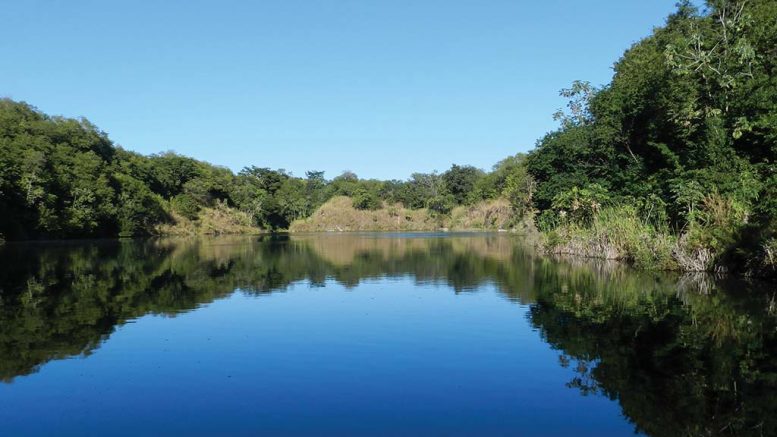Amarillo Gold (TSXV: AGC; US-OTC: AGCBF) recently tabled an updated prefeasibility study (PFS) for the Posse gold deposit on its 100%-owned Mara Rosa gold project in Goias state, Brazil. The study raises the project’s after-tax net present value (NPV) and after-tax internal rate of return (IRR), while lowering its initial capital expense.
The previous PFS in 2017 outlined a US$223-million, after-tax NPV at a 5% discount rate, 42% after-tax IRR and US$148-million initial capital expense.
The latest PFS assigns the project a US$244-million, after-tax NPV at a 5% discount rate, 51% IRR and US$123-million initial capital expense. Both studies base these numbers on a US$1,300 gold price.
The company recently helped kick off Red Cloud Klondike Strike’s 2018 Fall Mining showcase by presenting at the Omni King Edward hotel in downtown Toronto.
Amarillo CEO Mike Mutchler discussed the company’s ongoing 10,000-metre drill campaign at Mara Rosa. Amarillo is drilling the south end of the pit, focused on converting its 300,000 oz. inferred gold into the measured and indicated categories to include in a feasibility study in the first half of 2019.
The project has 31 million measured and indicated tonnes grading 1.3 grams gold per tonne for 1.27 million oz. gold and 11 million inferred tonnes at 0.92 gram gold for 330,000 oz. gold. That includes an in-pit, 23.8 million proven and probable tonnes grading 1.42 grams gold for 1.08 million oz. gold. At a 90.6% recovery rate, the company says it could produce 985,000 oz. gold.
The deposit is open for expansion along strike and down dip, and the company intends to use part of its drill campaign on a few step-out holes. The company’s property offers expansion potential across its 625 sq. km of exploration permits.
“We see a nice, high-grade zone that potentially we’d be able to chase underground with a future underground mine,” Mutchler said during his presentation.
Amarillo wants to start building an open-pit mine at Mara Rosa by 2020’s second quarter, with commercial production in mid 2021.
It achieved its first major permitting milestone in 2016. After holding a public meeting to discuss the project, the Brazilian government approved its preliminary licence. Roughly 600 of the 5,000-person village of Mara Rosa residents attended the meeting, giving what the company calls “overwhelming” support.
“One person complained — a farmer, who said he’d have to pay his workers more,” Mutchler said. “This is a complaint we like, because it means we’re raising the standard of living.”

Drillers at Amarillo Gold’s Mara Rosa gold property in Goias state, Brazil. Credit: Amarillo Gold.
The company is now trying to get an installation licence that would authorize it to begin construction and eventually commission. It intends to apply for the licence in late 2019 after completing its feasibility study.
According to the latest PFS, the project would produce 123,000 oz. gold per year over an eight-year mine life. It would produce a little more during the first four years, when it would average 144,000 oz. gold per year. It would require US$17 million in sustaining capital to fund a US$655 per oz. gold all-in sustaining cost. The company expects pay back in 2.3 years.
“It’s a very good time to have your costing in Brazilian real and your payable product in U.S. dollars,” Mutchler said.
One U.S. dollar is worth 3.68 Brazilian real. The country has just wrapped up a contentious presidential election that saw pro-business candidate Jair Bolsonaro assume office.
The company plans to use proceeds from Mara Rosa to explore its Lavras do Sul gold project in Brazil’s southern state of Rio Grande do Sul, where Amarillo is investigating 22 targets along a 100 km trend.
The 220 sq. km property contains 6.4 million indicated tonnes grading 1.5 grams gold for 215,000 oz. gold and 12.9 million inferred tonnes at 0.74 gram gold for 308,000 oz. gold, all on its Butia gold target.
Amarillo paid Rio Tinto (LON: RIO) US$1.26 million over several installments to acquire a 60% interest in the property at the end of January 2008. In optioning the property, Amarillo assumed Rio Tinto’s position in its underlying option agreement with the mineral rights holder. Rio Tinto has a back-in agreement to acquire 70% of the project by paying Amarillo three times its exploration spending, if it can amass more than 7 million payable oz. gold.
Amarillo drilled three holes into the project’s Butia zone in December 2006, cutting as much as 157 metres from surface of 1.05 grams gold. The company is performing ongoing soil sampling and geological mapping across several properties at Lavras do Sul, and conducting airborne magnetic surveys on its Butia, Caneleira and Zeca Souza targets.
Shares of Amarillo Gold are trading at 29¢ in a 52-week range of 19¢ to 42¢. The company has a $30-million market capitalization, with just over 114 million shares outstanding. It has $4.9 million in cash and no debt. Institutional investors own 46% of the company.


Be the first to comment on "Amarillo improves economics of Mara Rosa in Brazil"